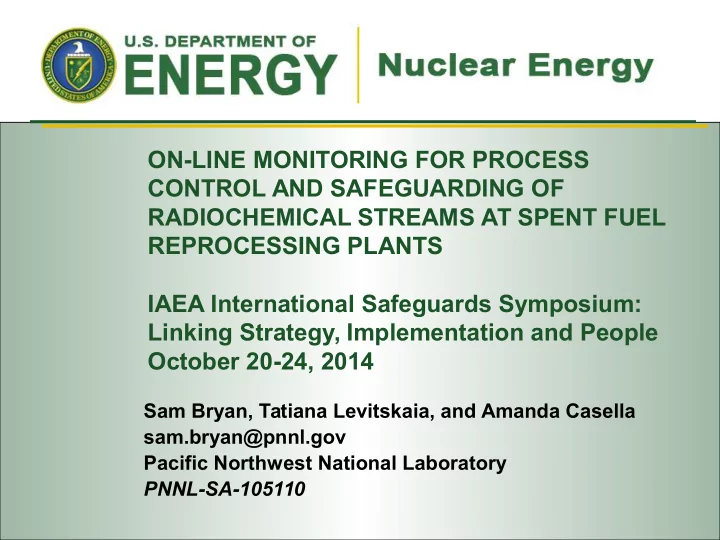

ON-LINE MONITORING FOR PROCESS CONTROL AND SAFEGUARDING OF RADIOCHEMICAL STREAMS AT SPENT FUEL REPROCESSING PLANTS IAEA International Safeguards Symposium: Linking Strategy, Implementation and People October 20-24, 2014 Sam Bryan, Tatiana Levitskaia, and Amanda Casella sam.bryan@pnnl.gov Pacific Northwest National Laboratory PNNL-SA-105110
Process Monitoring Can Be Achieved Throughout the Flowsheet Global vision: Process monitoring/control dissolved fuel at various points in U flowsheet CoDECON U, Pu, Np Tc Every flowsheet contains Monitoring of Raman and/or UV-vis-NIR TRUEX FPs strong acid active species or pH desired TALSPEAK Am/Cm Coriolis and conductivity instruments can be used on all process streams rare earths Monitoring Is Not Flowsheet Specific
Approach: Online Spectroscopic Measurements Raman measurements of – Actinide oxide ions – Organics: solvent components and complexants – Inorganic oxo-anions (NO 3 - , CO 3 2- , OH - , SO 4 2- , etc) – Water, strong acid (H + ), strong base (OH - ) – pH – weak acid/base buffer systems UV-vis-NIR measurements of – trivalent and tetravalent actinide and lanthanide ions Potential Uses – Process monitoring for safeguards verification (IAEA) – Process control (operator) Previous Experience – Real-time, online monitoring of high-level nuclear waste in tanks and to the waste pretreatment process – In discussions with actual reprocessing plants for demonstration
Methodology for on-line process monitor development: from proof-of-concept to final output Static measurements: Chemometric model On-line model verification Model training database development and translation Real-time on-line concentration data display Integrated software for data collection, processing, storage and archiving
Optical spectroscopy for monitoring UO 2 2+ , Pu, and Np species in fuel solutions Raman spectroscopy Vis-NIR spectroscopy Variable Pu(IV) in fuel feed simulant Variable UO 2 (NO 3 ) 2 in 0.8M HNO 3 Absorbance wavelength, nm Pu(IV) concentration variable 0.1 to 10 mM Detection limits : Feed composition: 1.3 M UO 2 (NO 3 ) 2 in 0.8 M HNO 3 • 3.1 mM for UO 2 • 0.08 mM for Pu(IV) UO 2 (NO 3 ) 2 does not interfere with Pu measurements
Proof-of-Concept : Applicability of spectroscopic methods for commercial BWR ATM-109 fuel measurements Commercial fuel: ATM-109, BWR, Quad Cities I reactor; 70 MWd/kg; high burnup Fuel dissolved in HNO 3 Performed batch contact on each aqueous feed with 30 vol% TBP-dodecane Feed, Organic, Raffinate phases successfully measured by – Raman, Vis-NIR Excellent Agreement of spectroscopic determination with ORIGEN code and ICP measurement Molar units Bryan et al. Radiochim. Acta, 2011.
Vis-NIR spectra of dissolved High-Burnup BWR ATM-109 Fuel: useful for Pu(IV, VI), Np(V, VI), and Nd(III) quantification Aqueous phase: ATM-109 feed, variable HNO 3 // Pu(VI) absorbance Nd(III) Pu(IV) + H 2 O Pu(IV) Np(V) Np(VI) + H 2 O Np(V)-UO 2 Nd(III) Pu(VI) Pu(VI) // wavelength, nm Bryan et al. Radiochim. Acta, 2011.
Flow Testing with PNNL’s Solvent Extraction Test Apparatus (SETA) Sixteen 2-cm centrifugal contactors installed within shielded glovebox Instrumented with Raman and UV-VIS-NIR spectroscopic probes PNNL’ s centrifugal contactors can be additionally instrumented to support instrumentation evaluation and modeling validation 8
Centrifugal Contactor System Instrumented with Raman and VIS-NIR Spectroscopic Probes Fiber optics for UV/Vis and NIR glove port centrifugal contactors cover Raman Probes installed within glovebox Raman Input fiber optics 9
Vis-NIR and Raman Multiplexer allows for multiple, simultaneous sensor locations on contactor system UV-vis Flow cell Raman Probe September 2011 10
On-line Spectroscopic Measurements test conditions centrifugal contactors; 2-cm, 3600 rpm Aqueous phase: 11 mL/min Organic phase: 11 mL/min Feed: 20 mM Nd(NO 3 ) 3 4M NaNO 3 0.1 M HNO 3 Organic: 30% TBP/dodecane (PUREX)
Safeguards Application: spectroscopic process monitoring of diversion scenario Solvent 30% vol% Loaded organic TBP/dodecane raffinate feed diversion test conditions Aqueous phase: 11 mL/min Organic phase: 11 mL/min Diversion experiment 3 mL/min of feed during flow test
Flow Test: Diversion experiment PUREX simulant, Nd(NO 3 ) 3 , HNO 3 , NaNO 3, TBP/dodecane Feed (aqueous) phase Flow rates and Amounts from Diversion Experiment 13
Spectroscopic measurements for diversion detection organic product (TBP/dodecane) phase raffinate (aqueous) phase absorbance time (min) wavelength (nm) 14
Diversion quantification: mass flow plus spectroscopic measurement delta from diversion Feed diversion started at 87 min Excellent agreement between process Organic + Raffinate monitor and mass balance measurements delta from in-process 2.9 x 10 -3 mol Nd 3+ diverted based on Organic mass balance Raffinate 3.0 x 10 -3 mol Nd 3+ diverted based on process monitor analysis delta from diversion delta from diversion delta from in-process 15
Conclusions Using simulants and BWR Spent Fuel – Demonstrated quantitative spectroscopic measurement on actual commercial fuel samples under fuel reprocessing conditions • Raman for on-line monitoring of U(VI), nitrate, and HNO 3 concentrations, for both aqueous and organic phases • Vis/NIR for on-line monitoring of Np(V/VI), Pu(IV/VI), Nd(III) Demonstrated mass balance in on-line contactor system using low cost spectroscopic process monitoring (~USD 90K) – During real-time centrifugal contactor TBP/dodecane extraction – Diversion of feed was quantitatively detected within contactor system – pH monitoring and simultaneous Ln (Nd 3+ ) monitoring demonstrated with TALSPEAK system Future plans for on-line process monitoring – Collaborative demonstration on commercial (larger) scale within a r eprocessing canyon/plant
Acknowledgements U.S. Department of Energy (DOE) – Fuel Cycle Research and Development (FCR&D), Separations Campaign (NE) – NNSA Office of Nonproliferation and International Security (NA-24) 17
Recommend
More recommend